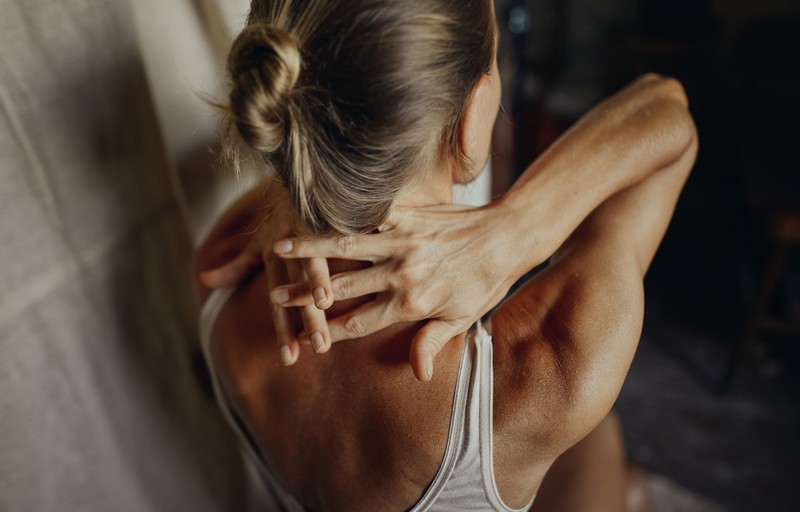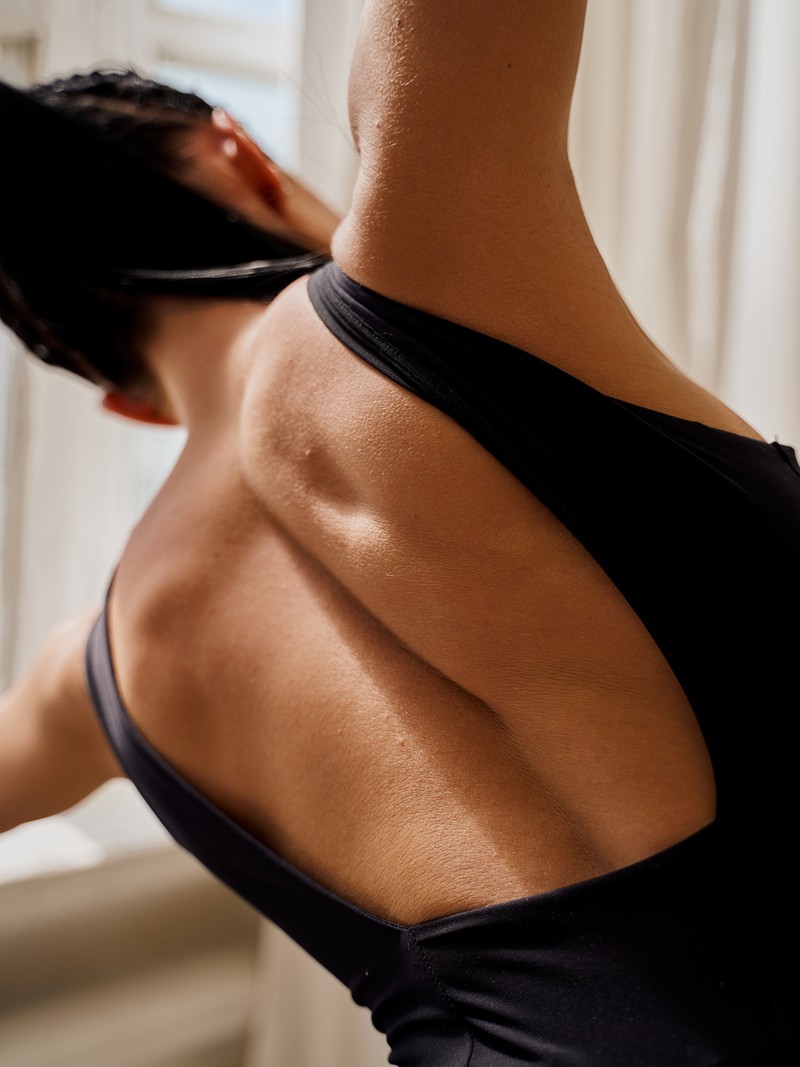A PT’s Guide To Dealing With DOMS
THE SIGNS
Pain 24 Hours After A Workout
“Delayed onset muscle soreness (DOMS) is the pain experienced 24-48 hours after exercise, making muscles sensitive to touch and stiffer. Pain tends to peak within three days of a workout and gradually diminishes. Muscles feel sore because of microscopic damage to the muscle fibres, which happens when your muscles work harder than they are used to, or you use muscle groups you don’t often reach in your regular workout. However, it’s different to a pulled muscle – DOMS is muscle damage, but it’s at the muscle fibre level as opposed to a deeper muscle tear.” – Emily Schofield, certified PT at Ultimate Performance
Decreased Range Of Motion
“DOMS can result in stiffness and soreness. It can temporarily reduce the flexibility and mobility of the affected muscles, and it can feel trickier and more uncomfortable to move. The affected areas may also appear slightly swollen and warm to touch due to the body’s inflammatory response.” – Florence Penny, physiotherapist & founder of Flow Physio
Short-Term Strength Loss
“DOMS often accompanies a feeling of muscle fatigue, where the affected muscles may feel weak or less capable of performing strenuous activities. Due to the soreness triggered by DOMS, there may be a temporary reduction in muscle strength and performance for a few days.” – Emily
WHAT CAUSES IT
A New Workout
“DOMS can happen after any type of exercise, but especially after exercise to which you are unaccustomed or ill-prepared for. So, if you run faster and longer than you usually do, or you suddenly lift heavier weights, don’t be surprised if you feel sore for the next couple of days.” – Florence
Certain Strength Moves
“Workouts that include a lot of eccentric exercises are more likely to cause DOMS. Strength exercises have two phases – the concentric (the phase when the muscle is shortening, usually the lifting part), and the eccentric (the part when the muscle is lengthening, typically the lowering part). The eccentric phase is where you’re causing tears in the muscle fibres, and it’s where your muscles are working their hardest. This is why moves like deadlifts, bicep curls and lateral lunges can lead to soreness.” – Florence
THE MYTHS
It’s A Sign Of A Good Workout
“DOMS is a normal reaction to muscle overload. As your muscles adapt, get stronger and become accustomed to the exercise, the occurrence and intensity of DOMs tends to decrease. An effective workout is far better determined by your progression in an exercise – perhaps you can lift heavier, or run further – as well as how quickly you fatigue, so no, DOMS is never a sign of a good workout. In fact, it probably means you’ve gone too hard, too soon.” – Florence
No Pain, No Gain
“Muscle soreness or DOMS does not equal better or quicker muscle-building or strength-building results. In fact, becoming too sore after a workout can be counterproductive to your goals, since you may find yourself skipping a few workouts due to the discomfort. There are varying degrees of muscle soreness depending on how much damage has been done, but regularly experiencing an extreme level of soreness isn’t something you should make a habit of.” – David Wiener, training & nutrition specialist at Freeletics
Stretching Can Help
“Research shows stretching as part of a cool-down has limited impact on post-exercise soreness. While static stretching may offer temporary relief for around half an hour, it does not provide long-term benefits for DOMS.” – Emily
Taking Ibuprofen Can Soothe Pain
“It’s a myth that taking anti-inflammatory drugs like ibuprofen can speed up muscle recovery. The truth is such drugs can hinder muscle growth by 50%. The inflammation caused by DOMS can be uncomfortable, but the process of inflammation tells the muscles to build back and repair. If you take ibuprofen, you’ll dampen the desired training adaptations and may struggle to recover quickly.” – Emily
Only Beginners Experience DOMS
“In reality, anyone can experience DOMS regardless of fitness level – it can even happen to seasoned athletes. Every now and then, you might get carried away in a fitness class, or do something your muscles aren’t familiar with – this will likely cause DOMS, regardless of how fit you are.” – Florence

HOW TO TREAT & AVOID IT
Prioritise A Warm-Up
“Warming up is essential to any workout, and you’re more likely to experience DOMS if you don’t warm up. There’s robust evidence that shows warming up thoroughly can help to reduce the onset of DOMS. On the other hand, studies show cooling down has no apparent effect on muscle soreness. However, cooling down is still a vital part of exercise as this process lengthens muscle fibres, and increases mobility and flexibility.” – David
Start Slowly
“If you’re new to exercise or heading back to the gym after time off, go slowly, especially if weights are involved. Overdoing it too soon can lead not only to muscle soreness, but worse, injury. Include an additional warm-up, especially if your workout will include compound moves like squats and deadlifts, and avoid pushing yourself to complete failure. Instead, use the time to refine your technique and gradually increase the intensity. If you’re a runner, lessen the intensity.” – Emily
Introduce Split Training
“A balanced strength training programme will ensure you’re splitting up muscle groups rather than targeting the same muscle groups each session. Pushing through intense exercise when muscles are already sore can potentially exacerbate the damage and prolong the recovery process, so it makes sense to take a balanced approach.” – Florence
Manage Stress
“Evidence shows chronically elevated levels of cortisol (the body’s stress hormone) accelerate the loss of muscle mass and increase inflammation. Managing your stress through meditation and relaxation techniques sets the scene for more effective recovery.” – Emily
Eat Well
“Nutrition can’t prevent DOMS, but it plays a crucial role in recovery. A balanced diet consisting of unprocessed, single-ingredient foods enhances your readiness for training. Focus on incorporating protein in each meal, including lean and fatty sources, along with omega-3-rich fish, fibrous vegetables, and healthy fats like nuts, avocados, or olive oil. When you are feeling sore, aim for 2g to 2.5g of protein per kilogram of your bodyweight. Adequate hydration is also essential as muscles have a high water content, and even slight dehydration can intensify soreness.” – Emily
Try A Protein Smoothie
“One of the best things you can do to avoid – or at least lessen – DOMS is to consume a protein shake, or protein-rich smoothie within one to two hours post-workout. Fast-digesting whey protein, in liquid form, shuttles essential amino acids around the body rapidly, which will help repair the muscles you’ve just worked in the gym and lessen the feeling of soreness the next day.” – Emily
Hit The Pillow
“Poor sleep will negatively impact recovery. In simple terms, bad sleep equals worse DOMS. Prioritise good sleep hygiene by keeping a regular sleep schedule, sleeping in a dark, quiet room, and reducing exposure to blue-light-emitting devices close to bedtime.” – Emily
Supplement With Vitamin C
“Vitamin C is a powerful antioxidant that plays a key role in muscle recovery. If consumed regularly, it can significantly reduce DOMS. As the body can’t make or store vitamin C, you need to get it daily. Good dietary sources include blueberries, oranges and peppers.” – David
WHEN TO TAKE A REST DAY
“DOMS isn’t serious, but it can limit daily activities and increase your risk of injury. To avoid complications, listen to your body, avoid overexertion, and prioritise proper rest and recovery. Consistently training through soreness may indicate you’re not getting enough rest – this will increase your risk of injury. If you’re too sore to train at the same or higher level as the previous week, take a day off or focus on different muscle groups.” – Emily
For more from the experts visit FlowPhysioLondon.co.uk, UltimatePerformance.com & Freeletics.com.
DISCLAIMER: Features published by SheerLuxe are not intended to treat, diagnose, cure or prevent any disease. Always seek the advice of your GP or another qualified healthcare provider for any questions you have regarding a medical condition, and before undertaking any diet, exercise or other health-related programme.
DISCLAIMER: We endeavour to always credit the correct original source of every image we use. If you think a credit may be incorrect, please contact us at info@sheerluxe.com.


